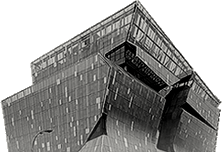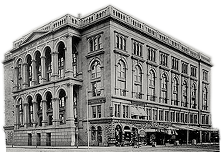New Research on How Ammonium Nitrate Forms Atmospheric Aerosols
POSTED ON: December 9, 2024

A paper describing research led by Robert Topper, professor of chemistry, has been published online in the Journal of Physical Chemistry A. The first author of the paper is undergraduate chemical engineering student Ubaidullah Hassan ChE’25, and the work included a collaboration with chemical engineering alumnus Miguel Amat ChE’01.
The work focuses on better understanding how ammonium nitrate (NH₄NO₃)—a highly dangerous yet essential compound—can form atmospheric aerosols during urban pollution events. In this research, Hassan, Amat, and Topper used TransRot, an open-source software project for predicting and analyzing the structures of nanoparticles using stochastic simulations. The program was developed and is maintained by one of Professor Topper’s sons, Steven Topper, as a continuation of an undergraduate research project he began in May 2020 (https://github.com/steventopper/TransRot).
Hassan used stochastic methods to roughly predict the structures of ammonium nitrate particles, and Amat refined and confirmed these structures using complementary methods. Hassan and Topper then carried out quantum-mechanical calculations using density functional theory and coupled-cluster methods. They used the results to analyze available experimental data and validate their methods. They then predicted which nanoparticles should exhibit the highest stability in an aerosol of ammonium nitrate at equilibrium. One of their more surprising predictions was that some of the larger, highly stable nanoparticles were pyramidal in shape—something that has not yet been directly observed in any experiment.
The article was invited to appear as part of a special Festschrift within The Journal of Physical Chemistry A honoring the career of Mark A. Johnson, a professor at Yale University who mentored Professor Topper early in his career. Johnson visited Cooper Union this semester to discuss his experimental laser spectroscopy and mass spectrometry research with chemical engineering students.
Preliminary versions of the work were presented at the 2023 meeting of the American Institute of Chemical Engineers in Orlando, FL (Hassan), and the 2024 American Conference on Theoretical Chemistry in Chapel Hill, NC (Professor Topper). In addition, Professor Topper gave a talk on TransRot at the Fall 2024 national meeting of the American Chemical Society in Denver, CO. In addition to Steven and Ubaidullah’s work, Professor Topper presented research by Jillian Frost ChE’22 M.Eng'24, Sangjoon Lee ChE’23, dual-degree chemical engineering student Andrew Kim, and high school senior William Wang.
Abstract
Understanding the formation and decomposition mechanisms of aerosolized ammonium nitrate species will lead to improvements in modeling the thermodynamics and kinetics of aerosol haze formation. Studying the sputtered mass spectra of cation and anion ammonium nitrate clusters can provide insights as to which growth and evaporation pathways are favored in the earliest stages of nucleation and thereby guide the development and use of accurate models for intermolecular forces for these systems. Simulated annealing Monte Carlo optimization followed by density functional theory optimizations can be used reliably to predict minimum-energy structures and interaction energies for the cation and anion clusters observed in mass spectra as well as for neutral nanoparticles. A combination of translational and rotational mag-walking and sawtooth simulated annealing methods was used to find optimum structures of the various heterogeneous clusters identifiable in the mass spectra. Following these optimizations with ωB97X-D3 density functional theory calculations made it possible to rationalize the pattern of peaks in the mass spectra through computation of the binding energies of clusters involved in various growth and dissociation pathways. Testing these calculations against CCSD(T) and MP2 predictions of the structures and binding energies for small clusters demonstrates the accuracy of the chosen model chemistry. For the first time, the peaks corresponding with all detectable species in both the positive and negative ion mass spectra of ammonium nitrate are identified with their corresponding structures. Thermodynamic control of particle growth and decomposition of ions due to loss of ammonia or nitric acid molecules is indicated. Structures and interaction energies for larger (NH4NO3)n nanoparticles are also presented, including the prediction of new particle morphologies with trigonal pyramidal character.




